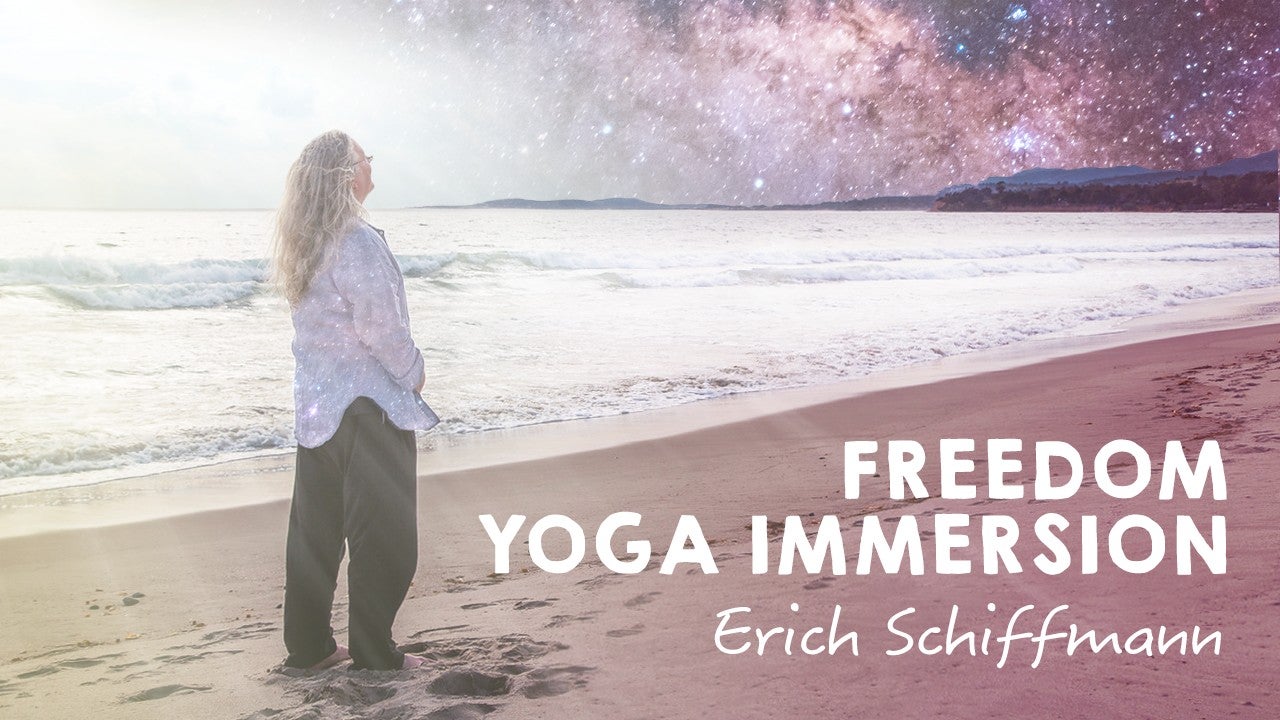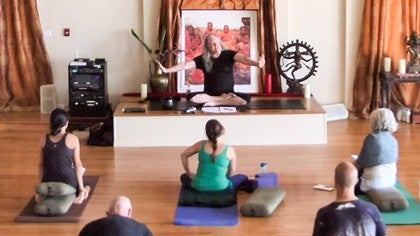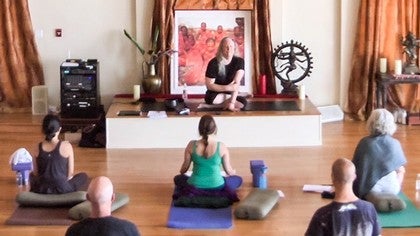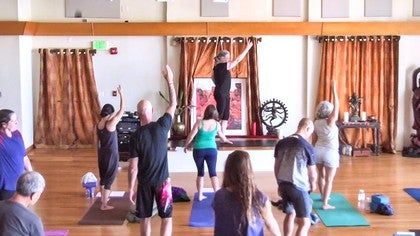Description
About This Video
Transcript
Read Full Transcript
So page 42, are you there? It says opening number three. This is the opening we've been doing primarily. I listed six openings that I might do in a class, but opening three, I've been doing that one for a long time. I like that one.
I think it's good. And I just want to make sure that it makes sense to you as you see it here. I wish I had done the drawings for it, but I didn't. It starts with the arm circles. Those make sense, right?
Shaking the hand, the arm, your foot, your leg. That make sense? Bent leg, artha, uthalas, and a hip sway. Does that make sense? The idea is you start with your feet hip-width apart.
You could just step your feet there, but every time I say start there, it's part of the assignment says thing. It's partly a just, it's just an awareness thing. Because remember, you want to cultivate your awareness. You want to like practice being attentive. So just sort of, okay, play the game.
Okay, start with feet hip-width apart. Deliberately step a little wider, a little wider, whichever way you go. Artha, uthalasana. Uthalasana is the standing forward fold. Artha means half.
So the bent leg, half forward fold, hip sway. That's when you go from side to side into your hips. The reason for doing that is just like easy opening and it teaches you to like sense the linger moments, the flow on moments. Most people can do it. That's a thing in classes.
You got to find stuff that people are okay with doing, especially like at the beginning. So doing that with your legs bent is nice. It's easy. And it's teaching people how to start listening for the linger moments, how to like go with the flow there. Again, an easy place to learn how to do that.
The twisting into it, that's clear, right? And then you fold down the middle. Number four is malasana, the squat with the four mudras, namaste, arms extended. I call this the Turkish position. My book is being translated into Turkish.
Now in my book I say bring your hands, like say on this, I say bring your hands into prayer position. And my Turkish friend who's translating the book said, well, I don't know, when we bring our hands into prayer position we go like this. Oh, so now I call this one the prayer, the Turkish prayer position. And man, I'd like this one. This feels to me more prayerful than this, you know what I mean?
Like this is like, this is good. I can see why people go like that, okay? So when it says Turkish, that's what I'm talking about. And then maitreya is the fourth one. So it's one, two, three.
The fourth one is you bring your palms into the prayer position, namaste, and then let your hands spin like this. I call it the maitreya mudra. I don't think that's the official name. I think there is an official name somewhere. I don't know what it is.
But I like calling this the maitreya mudra. Maitreya is like the future Buddha. This is cool. I like the feeling of this. And just let your hands mudrassize the way they feel like going, feel the meaning of it.
It feels like extending love and receiving love, like at the same time. You'll start seeing it in various sculptures every once in a while. On the first day, we then curled back up to standing, and then we repeated all those steps again. Most of the time, I don't curl up and repeat it again. But I did it on the first day just so that you would do those first four again.
Number seven here is you come to the all-fours position. And I talk about putting your hands in a particular way. And remember, like, the particular way is just one choice of many. Teach people, beginners, one choice. Then start clarifying that there's more choices, many choices.
You could do it like this. You know what I mean? It doesn't have to be symmetrical. It could be anything. But don't let it go out of the bag too fast.
You know, like, teach specific things so people do it safely. It helps them override their conditioning. You do the all-fours position, and I usually emphasize sinking to the down extreme, lifting to the up extreme. That's one of, like, the most obvious main variables in that pose. The idea on all of this stuff, remember, is just start being aware of what the main variables are and then what the options and choices are at each main variable.
So the main variable is what you're doing with your arms, and the choices are down extreme, up extreme, or somewhere in the middle. I haven't talked about it yet, but other main variables in that moment are what you're, how you're spinning your arms. I haven't said anything about that. I've just sort of been emphasizing this. That's sort of, like, enough to keep track of it first.
Then start talking about this, and usually what I say, because it's easy to keep track of, is you have the inner elbow facing each other. So it's easy to see whether someone's doing it. It's easy for them to see whether they're doing it, and it becomes obvious when something starts shifting. Usually when someone starts going up and down, their arms change, and you're just trying to bust them. But not bust them, but increase their alertness, you know?
And it's not so much that even then, like, it should always be like that. But you're just trying to get them attentive so they're not just being habitual, because the more attentive they are, the more they'll know which option is the right one to be doing. So I usually say have your inner elbows looking at each other. You could say, like, spin your arms so your inner elbows are facing forward. Just say something that you think is right, and then train your people to do that.
All fours, then I go into child's pose, and then I start with the dog pose thing. We've been doing dog pose three times. The first time, maybe just watch for a second. Or before I do it, if you just look on the next page, like page 43, the second to the bottom line where you can see the person's in dog pose. Or actually, like, the third line from the bottom, the third, fourth line there, like the third line from the bottom, am I being clear?
Yeah. It starts in child's pose, comes up to the all fours position, the person's arms are straight, the person's spine is straight. The third drawing there is you turn the toes under, straighten the legs, your hips come up, your arms are still straight and vertical, your spine is still straight and horizontal-ish, right? And then you start moving your, the fourth drawing is you move your butt back and up until your straight arms and your straight spine become a single straight line. That's what I call stage one. And on that fourth drawing, you can see that the person's up on their toes.
I've got the heels up off the floor. And the fifth drawing there is bending one leg and pressing the other heel towards the floor. That's what that little squiggle is. The second, the next line is the person's pushing both heels down to the floor, so that's the down extreme at the feet. It's stage one because the arms and spine are a single straight line.
And then to get out of it, you just sort of go in reverse. You move your shoulders forward until the arms are vertical, bend the knees down to the floor, point the toes, take it back into child's pose. That's a great way to get into dog pose. It teaches people like specific pieces along the way. I don't need a demo of that for you, but you get the idea.
Straight, straight, and you move your butt back and up until it becomes straight. The first time I do it with the heels up, the second time I do it like this one leg at a time, I might just start going one leg at a time, like that. And then you come way up on your toes to get the up extreme and pressing your heels down to get the down extreme. I don't always do it like that, but as teaching a song, you teach people learn it like this, learn it like this, learn it like that. To cat pose, you round your back.
So you're teaching people the options of spine, flexion, extension, flexion, extension, flexion, extension. Medium movements, 50% at first, the next repetition, a little rounder, next repetition, a little bit rounder, sort of like keep saying that a lot so people get that it's okay to not rush to the deepest extensions. It's smart to go slowly. If you go too fast, like the weak spots are going to open too soon and the stiff spots will get neglected. Go slowly so that every, it starts opening more evenly and repetitions are good because you just start feeling what it's about better.
And I like doing cat pose after dog because like dog, your spine is just basically straight the whole time so it's a little easier. You don't have to be as warmed up. Cat pose is an easy pose but there's more movement. It seems smarter to me to just do it second. So you're rounding and arching, doing repetitions.
I take it back to child's pose. And then number 10 is cat pose, put the side bends in. I do three times each side, 50% first time, 75% the second time, go for it the third time. And then you start the barrel rolls with your spine. Do you like those?
Those are good. Those are good. And again, like I would vote, like at that point, like try to isolate the movement. Like try to make like a clean middle C. Don't get too wiggly yet. It's interesting, like if you learn to make precise isolated movements, you'll actually become a better free former.
Whereas at first I thought, wow, free former, you just do whatever you want. But like be able to make, draw a straight line, draw a curve, a corner, draw a curve, you know, make isolated specific movements. Teach people what the specific movements are. Ten movements of the head, six movements of the spine, the various movements of the pelvis, your shoulders. Just sort of like get clear on what they are.
And taking it back to child's pose each time, sort of as a rest and then you come into the all fours again and you start circling your hips around your stationary knees, one direction and the other direction. And then let that begin to happen. Turn into whole body writhing and the writhing is cool. When I meditate, I get into writhing a lot. We haven't done it in here and I haven't talked about it.
I hardly talk about it, but you'll sit super quiet and like motionless conscious immobility and not move. But then just after a while, just let yourself start writhing. You'll get into really deep spots and it's like it's a weird looking, you watch somebody who just really gets in, I felt myself doing it once. It's like, it's weird and it feels so cool. I can just like get there and you get there and then come back to center and it feels really good to just park once again.
But again, when that first started to erupt through me, I didn't want to let it happen. I'm supposed to sit here, the time's not up yet or whatever the unconscious rules are. Okay, so like now, it's like I allow writhing and then it comes back to stillness. And here, when you're doing cat pose, you're beginning to learn to do whole body writhing. Okay, take it back to child's pose again.
I like to curl the head in and round, round your way up to the kneeling position. And number 12 there is you do the conscious pause, either in the kneeling position or the easy cross legged, which is sukhasana, okay. And then here it says memorize these patterns, visualize them. That's sort of like what we just did by reading about them. You can sort of get the feeling of what you're doing, even now as you're thinking about it and reading about it.
Feel them in your body as you mentally imagine flowing through the pattern. That's interesting. So you learn a song and you practice it and you practice it and you practice it and you practice it. It starts becoming your own. You start finding the linger moments, the flow on moments.
You start feeling where the lines of energy are and you give yourself permission to customize them, to deviate from the pattern and then come back to the pattern. Okay, so what we're going to do now, the way after we do the meditation, we're going to go through this, but instead of step one, the human teacher guiding you through it, the next step would be like you know what to do now. It's written down. It's next to you. You can like peek at the notes whenever you want.
You know, like it's not a test, but knowing exactly what to do will go through it and just practice going through it at your pace. Practice doing what the human teacher suggested. Practice getting into it a little bit more than you already are. Watch how you customize it. Watch how it starts getting more fun than it's ever been before.
You'll end up in the conscious pause and then we'll go to the next chapter. Okay, does that sound okay?






You need to be a subscriber to post a comment.
Please Log In or Create an Account to start your free trial.